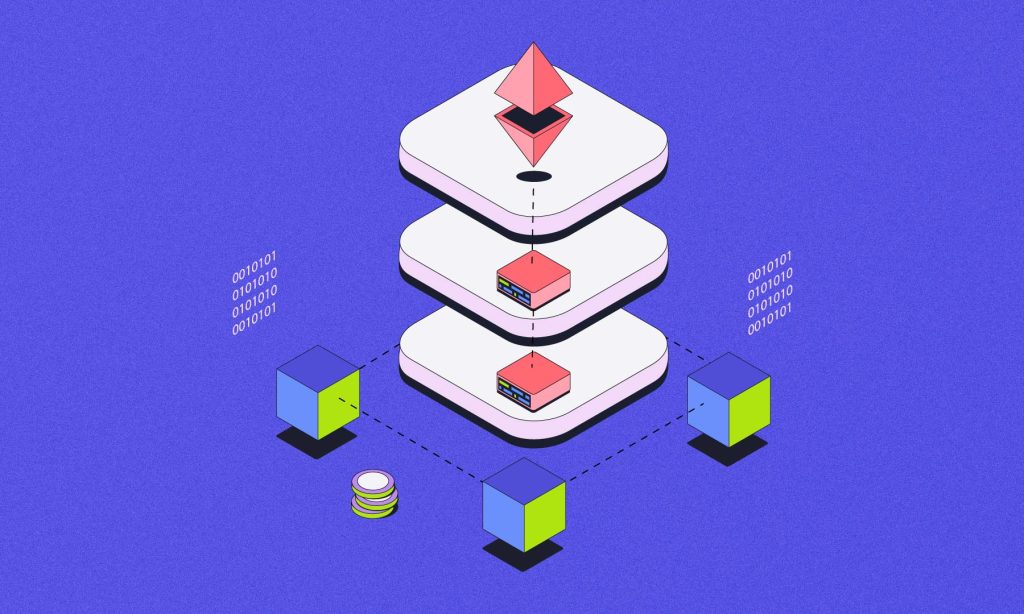As blockchain adoption increases, scalability remains one of the biggest problems for the current blockchains. Layer 2 protocols offer a second layer on top of the primary blockchain, increasing their scalability, security, and effectiveness. This article will discuss the top layer 2 protocols and layer 2 crypto coins in detail.
Knowledge of layer 2 protocols
Layer 2 protocols solve the scalability, transaction speed, and high gas fees problems that plague traditional blockchain networks. These protocols can manage numerous transactions by adding a layer on top of the primary blockchain.
Layer 2 protocols come in various forms, such as rollups, sidechains, and state channels. Users can conduct off-chain transactions through state channels more quicker and more affordable than on-chain transactions. With sidechains, programmers can build their own connected, smart contract-capable blockchains. On the other hand, rollups combine several transactions into one, lightening the burden on the primary blockchain.
Essential elements of networking technology are layer 2 protocols. These protocols specify how information is passed between networked devices. They make it possible for networked devices to communicate with one another, which is essential for business operations. Although many layer 2 protocols are available, the best offer quick, secure, and reliable data transfer.
Top layer 2 protocols for 2023
Here are some of the top layer 2 protocols for 2023.
Meter
Meter from Decentralized Finance Labs enables the smart contract to scale across different blockchain networks. The Meter system has two tokens: the governance token called MTRG and MTR.
Loopring
Loopring protocol enables you to build non-custodial, scalable Ethereum exchanges. It allows high-performance trading, and users have full control over their assets.
Polkadot
The Polkadot blockchain network is Web 3.0-enabled. Users can completely control their data. Ethereum co-founder Gavin Wood established Polkadot in 2016.
Carbon Protocol
The cross-chain protocol is a building block to DeFi. Carbon protocol allows users to integrate open financial markets for any asset type on any blockchain.
List of layer 2 crypto coins
Recently, the number of best layer 2 crypto coins has grown. We’ll discuss some of the top layer 2 crypto coins.
Polygon (MATIC)
Layer 2 scaling is a feature of Polygon, formerly known as Matic Network, for Ethereum. It uses sidechains to offload transactions from the main Ethereum blockchain and speed up and reduce the cost of transactions. Due to its inexpensive transaction fees and quick confirmation times, Polygon is becoming more and more well-liked. Decentralized exchanges (DEXs), gaming platforms, and other decentralized applications (dApps) have all grown significantly on the network’s platform.
Arbitrum (ARB)
An Optimistic Rollup architecture is used by the layer 2 scaling solution for Ethereum called Arbitrum. It aims to increase the Ethereum network’s scalability by enabling programmers to create decentralized applications (dApps) to manage large transactions. Because Arbitrum offers quicker and more affordable transactions, it appeals to both users and developers.
Optimism (L2)
Another layer 2 scaling option for Ethereum that makes use of an Optimistic Rollup architecture is called Optimism. It aims to increase transaction speed and efficiency while preserving the Ethereum network’s decentralization and security. Due to its high throughput and affordable gas prices, Optimism has become a popular choice among users and developers.
zkSync (ZKS)
Zero-knowledge proofs are used by zkSync, a layer 2 scaling solution for Ethereum, to increase the network’s scalability. Users and developers find it a desirable option because it enables quicker and more affordable transactions. Due to its efficiency and popularity, zkSync is a promising option for developing decentralized finance (DeFi) and other dApps.
Conclusion
Layer 2 protocols play a significant role in addressing the scalability and efficiency issues that the current blockchain networks are facing. To enhance the primary blockchain’s performance, security, and effectiveness, they offer an additional layer on top of it. Polygon, Arbitrum, Optimism, zkSync, Rollups Network, and StarkWare are just a few of the layer 2 protocols that have gained traction in recent years and are likely to impact the blockchain landscape in 2023.
Additionally, new layer 2 protocols that are in development and may provide even better answers to the scalability and efficiency issues with the current blockchain are worth keeping an eye on. L2 protocols will continue to be crucial in enhancing the functionality and scalability of the current blockchain networks as the blockchain industry develops. A larger audience can now use blockchain technology because developers and users can benefit from faster and less expensive transactions by selecting the best layer 2 protocol.
FAQs
What cryptos are Layer 2?
Ethereum, Bitcoin (via Lightning Network), Polygon, Loopring, and xDai are some cryptocurrencies with Layer 2 implementations aiming to enhance scalability and transaction efficiency on their respective networks.
What is the Layer 2 protocol?
Layer 2 protocol refers to a secondary solution built on top of a primary blockchain (Layer 1) to improve scalability, reduce fees, and enhance transaction speeds without modifying the underlying blockchain’s consensus rules. Examples include Optimistic Rollups, zk-Rollups, and Plasma.
Is Polygon the best Layer 2?
Polygon is a popular and widely adopted Layer 2 scaling solution for Ethereum, providing fast and low-cost transactions for decentralized applications (dApps).








